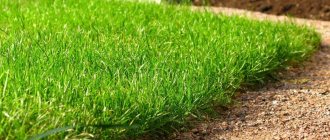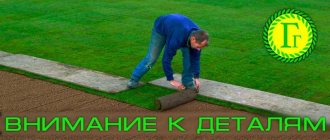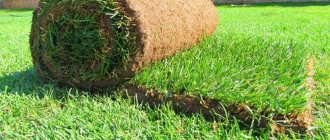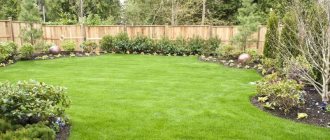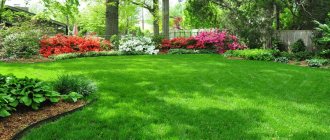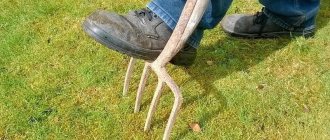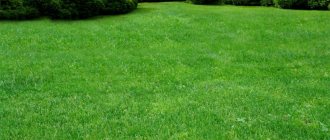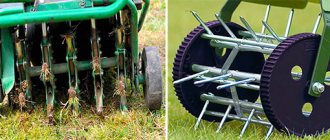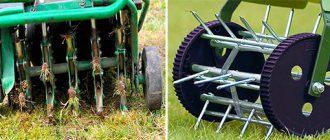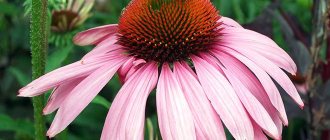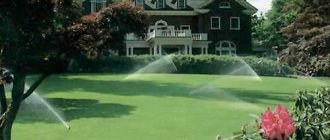Basic nutritional and strengthening elements for the lawn
The fertilizer for lawn grass must contain the following chemicals:
- Nitrogen. It affects the growth of green mass and color intensity. With its deficiency, the grass turns yellow, growth slows down, and areas devoid of grass appear on the lawn. Excess nitrogen is also undesirable: the stems become fragile, age, and susceptibility to disease increases. The nitrate form contained in ammonium nitrate and urea is best absorbed.
- Phosphorus. Promotes the accumulation of nutrients and strengthens the root system. Lack of the element leads to fragility of the stems, the leaves acquire a purple tint. An overdose is dangerous because the grass will not be able to absorb microelements, and phosphorus will go into an insoluble form and will no longer be absorbed by plants.
- Potassium. Provides water-salt metabolism and increases adaptability to heat and other extreme conditions.
- Microelements. They take part in the process of photosynthesis and have a beneficial effect on the formation and development of grass.
These substances can be added separately or in the form of complexes.
Types of fertilizers and lawn feeding
For the beauty and well-groomed appearance of lawn grass, it needs to be fed regularly. And you need to figure out which fertilizers are best to use. It should be noted that they come in a wide variety of forms: granular, liquid and solid.
And each of these types has specific application. Also, we should not forget that in addition to mineral fertilizers, organic species are also applied to the lawn. All types of lawn feeding are described below.
Did you know? In 2003, in the fields of the agricultural enterprise Agro
-
Soyuz” was set: within 24 hours, 1 unit sowed 571.9 hectares of spring barley. At the same time adding granules with fertilizer.
Nitrogen
The introduction of nitrogen-containing mixtures stimulates plant growth, and as a result, the lawn area is covered with a thick, bright green carpet. Please note that the loss of this important microelement occurs with cropping of the plant root. Therefore, it is necessary to pay attention to this type of feeding at a time when the grass is actively growing.
This type of fertilizer is applied for the first time in early spring, as soon as the crops begin to emerge from winter, around mid-April. The first dose is approximately 250 g per hundred square meters of lawn area. This dose stimulates plant growth. The initial feeding lasts for two weeks.
The next stage of working with nitrogen fertilizers is to apply them after the first mowing of the lawn grass, around mid-May. Subsequent feedings are carried out every two weeks. The last use of fertilizer will be feeding at the end of August.
Important! Nitrogen fertilizers come in two types, differing in their speed of action: fast and slow. Fast ones are used in spring, slow ones in autumn.
Nitrogen-containing fertilizers are considered:
- urea;
- ammonium nitrate;
- ammophoska;
- nitroammophoska.
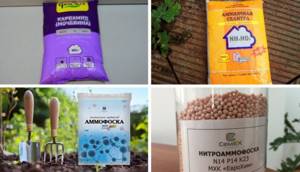
Phosphorus
The positive effect on the lawn from applying phosphorus fertilizers is the strengthening of the root system of the turf and an increase in the feeding area for plants. An additional bonus will be the active formation of young side shoots. This microelement has a useful property - the ability to remain in the soil for a long time. Therefore, you can apply it once as a fertilizer to the soil, and throughout the season it will provide nutrition to the lawn grass.
Pay attention to information about planting lawn grass that kills weeds.
This type of fertilizing can be done both in spring and early autumn. This type of feeding includes double superphosphate and simple superphosphate. These fertilizers help the grass to better withstand winter cold.
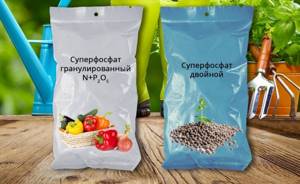
Potassium
Potash fertilizers help keep your lawn in excellent condition. They should be applied throughout the growing season. If fertilizing is done in the fall, it provides the grass with a good supply of vital energy, and also makes it resistant to climate change, diseases and various pests.
Important! In preparation for winter frosts, potassium plays a special role, like other elements. By promoting the development of frost resistance in plants, it prevents the appearance of many diseases.
In the autumn, you can use complex compounds and potassium sulfate. The minimum requirement is to apply once a year, because potassium is very quickly washed out of the soil.

Perhaps the need for this particular microelement in plants is not as high as for nitrogen or phosphorus, but still it should not be neglected. It stimulates grass growth, provides a bright green color, and makes the plant stronger and more resilient.
Find out also about the reasons for yellowing of lawn grass.
Complex fertilizers
A very convenient solution for feeding lawn grass is the choice of complex formulations. These are ready-made mixtures that combine all the elements necessary for a plant, selected in the correct dosage and intended for a specific time of year.

They contain the entire list of useful microelements necessary for the life of the plant. These mixtures include nutritional components in the required dosage. This is very convenient for the gardener.
Here you can read about how to control clover in your lawn.
Such fertilizers include:
- nitroammophoska;
- nitrophos;
- ammophos;
- potassium phosphate.

These mixtures are not intended for use on young grass. If the lawn is seeded, then the complexes are used after a year of cultivation, but if the lawn is rolled - after six months. There are also commercially available formulations designed for feeding at different times of the year, since turf needs different nutrients. The approximate application rate is 25–30 g/m².
Important! At different times of the year, lawn turf needs different feeding compositions. Special complexes are formulated with different proportions of necessary substances, based on seasonality.
Liquid fertilizer
Liquid fertilizers are designed to quickly restore a lawn that has been damaged for any reason. This type of fertilizer quickly reaches the root of the plant and saturates it with the necessary nutrients. They can be soluble or concentrated. They are diluted with water in the proportion specified in the instructions. Such compositions are able to quickly absorb and deliver nutrients to the plant through its root system.
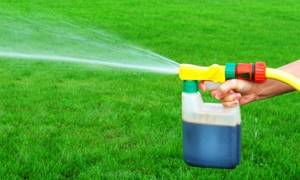
Such concentrates are used twice a year: in spring and summer. After use, the lawn should be watered to avoid burns to the green surface. Can also be used by spraying. In this case, the necessary microelements penetrate through the leaves and stems.
It is usually used not at the hottest time, so that the solution does not evaporate too quickly. Such fertilizers are applied once every two weeks. The approximate norm would be 80 ml of the substance, diluted in 12 liters of water. This amount is enough for about 5 m².
Did you know? From July 31 to August 1, 2014,
4217 tons of manure were used as organic fertilizers on an area of 221.80 hectares in 24 hours.
This was done with the help of powerful T9 tractors and allowed to set a world record. In order not to burn the green cover, after using such concentrates it should be watered well. Watering also promotes rapid delivery of substances directly to the roots. Foliar feeding with liquid fertilizers is also used. To do this, you need to dilute a solution of low concentration and spray it on the lawn grass. Then the plants receive the necessary help through leaves and stems.
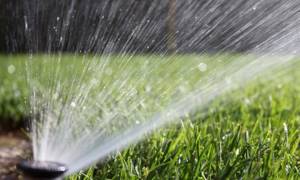
When using this type of fertilizer, they are distributed more evenly throughout the lawn, but this method of feeding is more labor-intensive. Spraying is carried out on cloudy days, because direct sunlight contributes to the rapid evaporation of substances from the leaves and the fertilizer does not have time to benefit the plant.
Dry feeding
Dry types of fertilizer include urea, nitroammophoska, granulated nitrate and others. The application rate is considered to be 10 g per m². However, the dose may need to be adjusted. The condition of the area should be monitored.
Important! After applying these types of fertilizers, water your lawn thoroughly. This is necessary to dissolve the granules and avoid burning the grass.
If you have to mow the lawn once a week, then the plants have enough nutrients. If mowing is done several times a week, then it is probably necessary to reduce the dose of dry fertilizing.
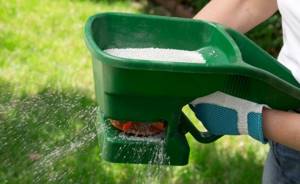
Lawn grass needs to be looked after almost the entire season to maintain its beautiful appearance. Timely application of fertilizing and fertilizers is considered one of the most important rules in proper lawn care. Thanks to these activities, it becomes possible to maintain the balance of beneficial microelements in the plant, as well as to enjoy a vibrant lawn throughout the year.
How to fertilize the lawn?
Feeding is done taking into account the time of year.
in spring
To wake up the grass after winter and “push” it to intensive growth, you should add useful components immediately after the snow melts. For this purpose, nitrogen fertilizers are used for the lawn.
What else can you fertilize your lawn in spring? Among liquid products, a special complex “Bona Forte” is suitable, which is used every 10–15 days. Consumption – 80 ml (2 caps) per bucket of water, the solution is enough for 6 m2.
In summer
At this time, plants require a lot of phosphorus and potassium. In nitroammophoska the amount of these macroelements is balanced. The nitrogen contained in the complex is quickly washed out of the soil by rain; its deficiency is noticeable by the pale color of the grass. Lawn urea (carbamide) or ammonium sulfate will help here. Product consumption – 20 g per 1 m2.
In summer, lawn grass is fertilized twice with potassium salt.
In rainy weather, fertilizing is carried out more often, since potassium is susceptible to leaching.
In the last months of summer, the application of nitrogen needs to be reduced, so mineral fertilizers for the lawn such as superphosphate in the amount of 40–60 g per 1 m2 or potassium sulfate (25–30 g for the same area) are used.
in autumn
Proper autumn feeding of the grass will allow the lawn to prepare for winter. In front of it, increased grass growth is undesirable, so nitrogen is excluded from the composition of fertilizer mixtures.
Double superphosphate, which has a long-lasting effect, is no less relevant for applying in the fall. The norm is 70 g per 1 m2.
Before winter, it is recommended to fertilize the lawn with manure, which by spring will rot and become a source of nitrogen.
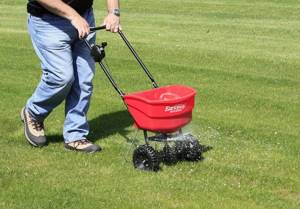
Fertilizer Fertika lawn spring-summer
The main period for using Fertik fertilizer is the time of lawn establishment, maintenance and vegetative growth. Available in granular form. The mixture in the bag is prepared in a ratio of 11.3:12:26 + microelements, where 11.3% nitrogen, 12% phosphorus and 26% potassium. Sold in several formats - 5, 10, 25 kg. During use, the following features must be taken into account:
- During planting, the fertilizer should be located in the upper loosened layer of soil. Afterwards, the granules are mixed with the soil and the soil is compacted to obtain the result. For 10 sq. m of land, 1 kg of fertilizer is used.
- If the mixture is applied to wake up after winter, then the fertilizer is applied immediately after the snow melts until mid-August. Be sure to remove leaves, branches and other debris. The soil is moistened before planting. For 10 sq. m, 500 g of the mixture is added.
- During vegetative growth, apply once after every second mowing. If the grass is mowed weekly, it is fertilized with Fertika every one to two weeks. For every 10 sq. m, 700 g of granules are scattered.
Positive aspects of lawn fertilizer:
- the grass becomes thicker;
- acquires a more saturated color;
- after cutting, rapid growth is observed;
- weeds do not grow.
Negative aspects of use:
- not detected.
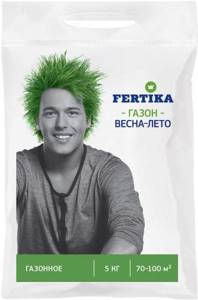
How to fertilize a lawn?
An indispensable condition for care is the correct application of fertilizers. The procedure is carried out in two ways: by scattering the preparations dry and in liquid form, the main rule is uniformity of distribution.
Granular products are used by scattering; application rates are indicated on the packaging. The gardener can adjust the application by observing the effect of the fertilizer on the condition of the lawn. Typically, cutting is done when the grass grows halfway. If you have to mow more often than twice a week, then the amount of fertilizer applied should be reduced.
How to feed your lawn in the fall
The main goal of autumn feeding of lawn grass is to strengthen the root system and prepare it for a successful winter. It is recommended to fertilize a green lawn in the fall with mineral compounds containing, first of all, potassium and phosphorus. It is these elements that contribute to the harmonious care of the grass stand for winter dormancy and guarantee early spring rapid development immediately after the melting of the snow cover.
Pay attention to the so-called NPK formula - based on the first letters of the elements - nitrogen (N), phosphorus (P) and potassium (K). The percentage of these substances will be a guideline. Their ratio should be approximately 10/30/20.

BonaForte autumn lawn fertilizer contains iron
Potassium is especially important because it increases the frost resistance of plants, their resistance to drought and disease. Phosphorus is also needed in the fall, as it affects the development of the root system. At the same time, it is not recommended to use products containing high portions of nitrogen to fertilize the lawn in the fall, since this substance is responsible for the rapid growth of the above-ground part, which should, on the contrary, be slowed down before the onset of frost.
If you doubt whether you can independently choose the required composition of fertilizing, then you can use ready-made special mixtures marked “Lawn grass. Autumn fertilizer." For example, lawn fertilizer BonaForte (formula NPK 8/30/20) or Fertika Lawn Autumn (NPK 6/1 3/36). In addition to the mentioned phosphorus, potassium and nitrogen, such fertilizers additionally contain other microelements - iron, magnesium, silicon, sulfur, calcium and others. And in combination with zeolites, their action becomes prolonged, and, as a result, fertilizer can be applied less frequently.
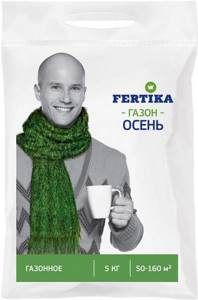
Fertika-Lawn-Autumn fertilizer is enhanced with sulfur, molybdenum, silicon and many other microelements
Choosing lawn fertilizers
The modern agricultural market offers a wide range of fertilizers for lawns. To choose the right product, they are guided by the time of year and the purpose of fertilizing, and also take into account the type and composition of the soil, the climate of a particular area and the type of grass sown.
Mineral
Among simple substances, an excellent spring fertilizer for the lawn is ammonium nitrate, which contains nitrogen in an accessible nitrate form. It will help the grass grow at low temperatures (from +5 C°).
The following substances will help you absorb potassium:
- potassium salt;
- potassium chloride;
- potassium sulfate;
- kalimagnesia.
Complex
Among the most popular are the following names:
- Nitroammophoska. It is scattered over the lawn and then watered; from 20 to 40 g of product is consumed per 1 m2.
- Fertika Universal 2. Take 40 - 50 g of the drug per square area.
- Superphosphate "Doktor Grin" for autumn feeding.
- "Pokon for the lawn" includes all the necessary macro- and microelements. It is laid in the spring when planting a new lawn. Nutrition is gradually released and reaches the roots with irrigation water and precipitation. Take half a measuring spoon (20 g) per 1 m2.
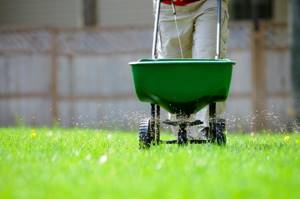
If you need to quickly help a lawn that has suffered from weather disasters, the best remedy is liquid fertilizer. Ready-made complex fertilizers are often used:
- Hidro Mouse Liquid Lawn;
- Bona Forte;
- Micro Plus;
- Flora Micro;
- Arteko N-15;
- Bio-Don is a biostimulant.
Simple substances (urea, etc.) can also be used in liquid form. Due to the fact that the fertilizer reaches the roots dissolved, the action begins much faster. The drugs immediately penetrate the soil and have a positive effect on the plants. Solutions should be prepared exactly according to the instructions on the packaging.
Fertilizer Azofoska (Nitroammofoska)
The complex mineral product is intended for use in spring and summer. It is not recommended for use as an autumn fertilizer to maintain beauty and increase growth. The mixture in the bag is prepared in a ratio of 16:16:16, where phosphorus, nitrogen and potassium are contained in equal proportions. Available in the form of small crumbly granules. Contains sulfur. Available in only one form - bag weight 50 kg. Features of using the product:
- For use on lawns, apply to the soil surface using a spreading motion. Proportions – per 100 sq. m no more than 3-4 kg or 30-40 g per 1 sq. m. m.
- Immediately after fertilizing, the lawn is watered with cool water to quickly transport substances to the roots.
Positive aspects of using Azofoska fertilizer:
- granules contain 40% of useful substances;
- is not washed out of the soil by water for a long time;
- versatility of use - crop production, gardening, growing grains, ornamental crops;
- nutrients are quickly absorbed by plants;
- the ability to resist adverse weather increases;
- has no expiration date.
Negative aspects of use:
- not detected.

General rules and recommendations
Let's consider the main points that need to be taken into account when feeding lawn plantings:
- Complex mineral compositions are not suitable for fertilizing young grass. They are applied only to the lawn of the second year or 1.5 years after planting (in the case of a roll variety). It is better to feed young grass with organic matter and do this before sowing. If the land is fertile, then there is no need to fertilize in the first year.
- At the dacha, it is more convenient to scatter fertilizers with your hands, using protective gloves. The granules are scattered first along the lawn, then across it. The amount of fertilizer should be calculated according to the area of the site.
- Preparations in liquid form are applied using a watering can in a manner similar to the previous option.
- Before applying fertilizers, get rid of weeds, and after application, water the lawn.
- Due to uneven application, patches of scorched grass may appear on the lawn. In this case, stop feeding and begin intensive watering.
Caring for a green lawn is not difficult, you just need to learn the basic rules and methods of fertilizing.
Universal fertilizers
There are many fertilizers that are suitable for any type of lawn, applied in the fall.
1.“Complex mineral fertilizer for preparing the lawn for winter” TM Russian Lawns
. It contains all three basic elements: nitrogen – phosphorus – potassium in the ratio 3–11–44. The drug provides:
- regulation of tissue water balance;
- protection of cells from damage by ice fragments;
- prevention of fungal infections;
- rapid activation of the plant organism after a period of dormancy.
2.Lawn fertilizer Florovit
Suitable for both autumn and spring feeding. In addition to the basic elements, the composition includes iron, which helps fight the appearance of moss. Florovit increases the grass's resistance to low temperatures, and water-soluble phosphorus promotes better absorption. Replenishment with this composition is carried out from August to early October.
3.REASIL for lawns
is a liquid organomineral complex rich in micro- and macroelements: nitrogen, phosphorus, potassium, magnesium, iron, copper, zinc, sulfur, manganese, cobalt, molybdenum, boron. It also contains vitamins B1, B3, B12, C, and organic acids: succinic, citric. The composition of REASIL is significantly superior to other mixtures in its diversity. The concentrate is diluted with water and the prepared solution is used as irrigation.
4. WMD lawn autumn
– organomineral complex containing NPK in a ratio of 2:5:10. There are essential microelements such as magnesium, zinc, iron, copper. The complex is complemented by boron, molybdenum and manganese. Of the organic compounds, the fertilizer contains humic components.
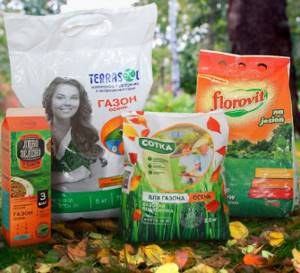
When choosing a fertilizer , be sure to pay attention to the nitrogen content in it.
It should be several times less than phosphorus and potassium.
Rules for applying fertilizing
Prolonged drought is one of the unfavorable moments for fertilizing. Fertilizing will benefit lawn plants only if the grass is dry and the soil underneath is moist. Although there are benefits to applying fertilizer, you need to know when to do it.
- If the dry period lasts long enough, then proceed as follows: first you need to water well, then you need to wait for the water to be absorbed and the grass to dry. And after this you can proceed to treating the soil with fertilizers.
- When applying dry fertilizers, you must ensure that they are distributed in even portions over the lawn area. Otherwise, there is a risk that such treatment will subsequently lead to the appearance of burns and unsightly brown spots on the grass.
- To eliminate such dangers, it is recommended to carry out processing with special fertilizer spreaders.
Lawn care involves many activities, among which autumn fertilizing is of great importance. However, even in such a seemingly simple matter, certain nuances must be taken into account.
Bearing in mind that throughout the summer season, lawn grass goes through various stages of development, you need to know what kind of fertilizers and at what time of year are best applied to the soil for the lawn.
You need to be especially careful in the fall, because if during this period you feed lawn plants with elements that stimulate the growth of green mass, this can worsen their condition , which is why they will not be ready for winter, and this will negatively affect them next spring.
Applying fertilizers according to the seasons
As soon as the cold weather has receded and the first greenery is planning to hatch, it’s time to select the best fertilizers for your lawn in the spring. Those that will ensure rapid growth and give strength to the grass. Before treatment, the area is cleared of dead leaves and debris; if the ice has not completely disappeared, it is pierced with a pitchfork.
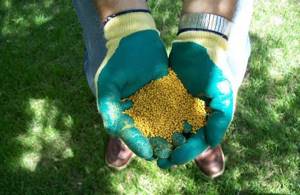
Spring and summer work
The full cycle of spring work begins with draining melt water from the area, leveling the lawn along the contour, aerating and filling bald spots. This is followed by the application of fertilizer for growth and subsequent cutting.
Each event has its own meaning and time. If you do not remove the melt water, the new growth will hurt. The drainage is constructed from broken bricks or gravel; a more expensive option is to install drain grates. To strengthen the roots, a special roller is rolled across the lawn or compacted with boards. Aeration is provided by piercing the soil with a pitchfork. The distance between the holes is no more than 15 cm. If bald spots are noticed on the lawn, the areas are dug up, and good soil or compost is added to the holes, where the seeds are placed. All that remains is to fertilize and water the sprouts in time.
In summer, the grass loses its beauty under the scorching rays of the sun. To avoid problems, regular watering, mowing and weed removal are necessary. Lawns are mowed approximately once a week. Aeration is carried out taking into account the soil moisture, but not in the rain. The weeds are pulled out by hand, and selective herbicides are purchased for large areas.
Autumn events
Fertilizing your lawn in the summer differs from the care that is planned for the fall. Watering is no longer as frequent, and in rainy conditions it stops altogether. September is a good time to aerate and clear your lawn of fallen leaves from trees. Nitrogen is not needed, and other additives with calcium and phosphorus are added only before the first frost.
Russian lawns
This company sells not only its own lawns and grass mixtures, but also produces mineral fertilizers. Three products from this manufacturer deserve special attention - complex mixtures for laying a lawn, feeding it during the growing season and preparing it for winter.
At each stage, Russian Lawns fertilizers provide the grass with nutrients in optimal proportions, so that the lawn grows luxuriantly in the spring, feels and looks good in the summer, and successfully survives the winter.
Russian lawns
